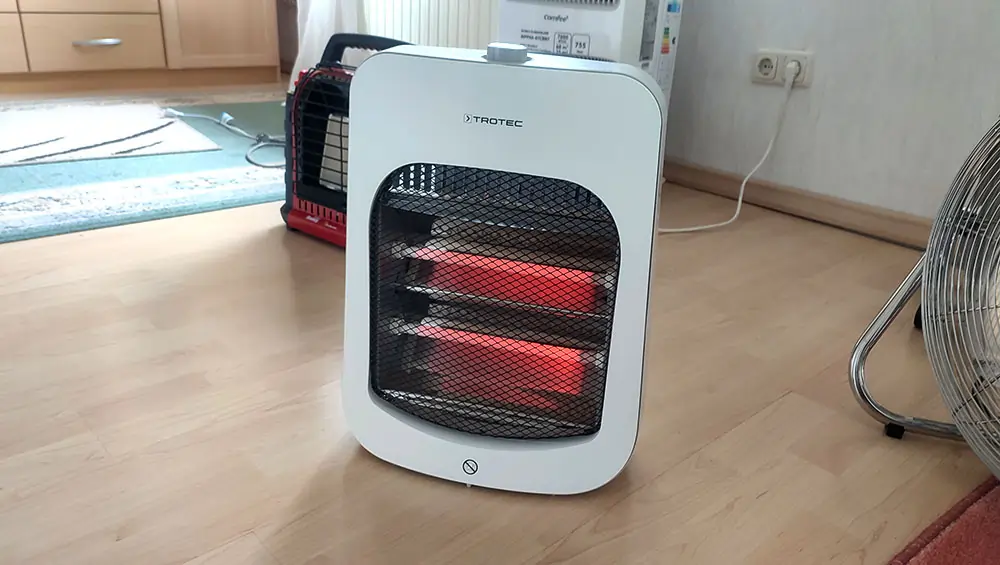Ceramic heater or infrared heater? Which one is more energy efficient and produces the most heat for the least cost?
When it comes to heating up your space, especially in those colder months, making an informed decision about which heater to use can save you both energy and money.
With many options available, two popular choices often come up: ceramic and infrared heaters.
But which one is more energy efficient? Is there even a difference efficiency-wise?
There are two kinds of efficiencies:
- technical energy efficiency (… boring)
- perceived energy efficiency (how much you actually feel)
In this post, I’ll break down the true efficiency of these heaters. I’ll try to spare you all the technical jargon about Watts and whatsoever and get straight to the answers.
After this explorative post on ceramic and infrared heater heating efficiencies, you’ll know exactly which heater to get and why.
And to answer one of your most urgent questions right away…
Quick answer: Ceramic and infrared heaters have the exact same technical energy efficiency. However, their perceived heating efficiency differs. Ceramic heaters need time to heat up the air, while infrared heaters immediately emit focused heat rays. Ceramic heaters need insulation to trap the hot air, infrared heaters don’t.
Recommended infrared heater
Based on all the things we’re uncovering later, here is my single top recommendation (to spare you the time).
For 99% of people, a good infrared heater far outperforms a ceramic heater in both heating efficiency and durability.
My all-time favorite infrared heater is this Dr Infrared Heater (click here to view it on amazon).
I’ve already written a complete “best infrared heater” review about this particular model.
I like this infrared heater because it heats a lot, it heats quickly, and it lasts you a lifetime.
If you were just looking for a good, solid heater, you can stop reading this article here, get the Dr Infrared, and continue living a happy life.
But, of course, this is heatertips.com, the most authentic and honest home heating website you’ll ever see. I am not making things up.
So, let’s have a very close look at both ceramic heaters and infrared heaters. Let me show you exactly how ceramic heaters and infrared heaters differ so you understand why you should rather get the infrared heater.
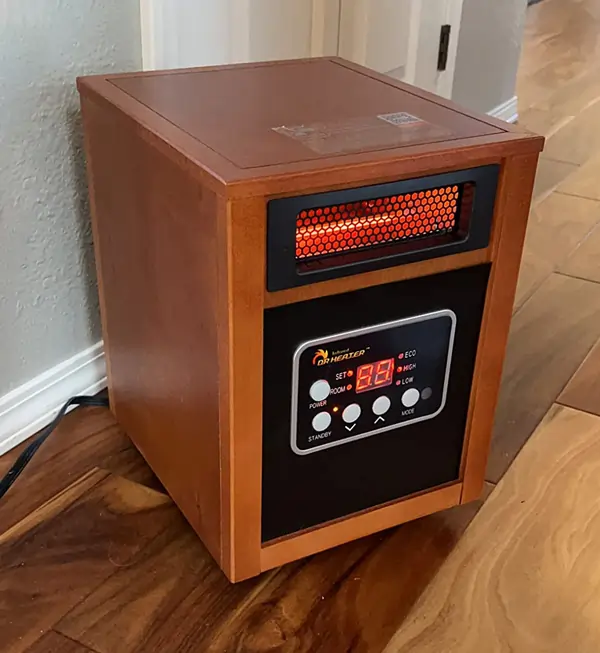 The Dr Infrared heater is my all-time favorite infrared heater!
The Dr Infrared heater is my all-time favorite infrared heater!
Comparison of ceramic and infrared heaters
Here’s a table with all the important properties of ceramic heaters and infrared heaters. If you understand the contents of this table, you’ll already know more about heaters than 90% of the population.
If some things are unclear, don’t worry, I’ll clarify everything in the section afterward!
| Feature | Ceramic Heaters | Infrared Heaters |
|---|---|---|
| Heating principle | Heats up ceramic plates to warm the air (which is good when multiple people are around) | Emits focused infrared rays which heat whatever the heater is in front of the heater (ideal for individuals) |
| Energy Consumption | Equal: Usually 1,500 Watts | Equal: Usually 1,500 Watts |
| Perceived Efficiency | Produces warm air (like a hairdryer) | Direct radiation (feels like the sun or fireplace) |
| Heat-up time | 10 minutes or longer depending on room size | A few seconds |
| Best Placement | Areas where warm air can be trapped (e.g., under a desk, or in a small room) | Wherever you need it, works everywhere (even outdoors is possible) |
| Distance Factor | Placing a ceramic heater closer to you increases warmth, but a lot of heat passes by you | Placing an infrared heater closer to you increases warmth exponentially (since infrared rays are more focused at a small distance) |
| Noise | Often have built-in fans, which create noise | Perfectly silent, no noise at all |
Energy efficiency vs perceived energy efficiency
When talking about the energy efficiency of heaters, it’s essential to differentiate between technical energy efficiency and perceived energy efficiency.
What’s technical energy efficiency?
Technical energy efficiency describes how much electric energy you have to invest in order to get a certain amount of heat energy from of a heater.
Some physics basics are enough to know everything about technical energy efficiency:
According to the first law of thermodynamics, energy cannot be created or destroyed, only transferred or converted from one form to another.
In the case of heaters, they work by converting electrical energy into thermal energy (heat). All electrical energy consumed by a heater is transformed into heat.
And actually, this is the case for anything. Energy input will always result in heat (sooner or later).
For example, when you turn on a lightbulb, it produces light and heat. The light part of the energy eventually becomes heat as well.
“In most devices, heat is waste energy”
In a heater, luckily, producing heat is exactly what we want. This means that none of the energy input in a heater is wasted.
And since there is zero waste, heaters are always 100% efficient.
Hence, if two heaters are rated at the same wattage, they’ll produce the same amount of heat.
Both ceramic and infrared heaters are 100% efficient in their energy-to-heat conversion.
However:
Technical energy efficiency is meaningless since it does not account for where the heat energy goes!
Why perceived energy efficiency is much more important
I honestly don’t know if this term actually exists, possibly I invented it.
Perceived efficiency is how we feel and experience the heat generated by a heater.
This perception can vary depending on how the heat is distributed, where the heater is placed, and how it interacts with our surroundings and us.
One simple example:
Imagine you have two infrared heaters. Now, you place one heater 10 feet away from you, and the other heater you place 1 foot in front of you.
Both heaters have the same technical efficiency of 100%. But the heater standing 1 foot in front of you feels incredibly hot, while you barely notice the other.
So, perceived energy efficiency is all about how much heat you actually feel. Perceived energy efficiency is what really matters.
How ceramic heaters distribute heat and how it feels like
Ceramic heaters mainly produce hot air. They use a ceramic plate to heat the air, which then circulates around the room.
This means the hot air rises, displacing the colder air, creating a cycle that gradually warms up the entire room.
A ceramic heater increases room temperature by blowing hot air into the room.
Ceramic heaters distribute the heat evenly within a room.
While they might take a bit longer to make you feel warm compared to infrared heaters, they are good at heating enclosed spaces where the warm air can be trapped, like under a desk or a small room
While writing this, there’s one thing I noticed:
Basically, there is no difference between a ceramic heater and a hair dryer.
I just had a quick Google search and, indeed, there are dozens of hair dryers advertising “ceramic technology”.
I doubt the ceramic heating industry will like this, but:
There is no technical difference between a hair dryer and a ceramic space heater.
Just like a hair dryer, ceramic heaters blow air over a ceramic heating element.
Since ceramic heaters emit a stream of hot air, the heat coming from a ceramic heater is very dry. It dries out your skin, hair, and plants.
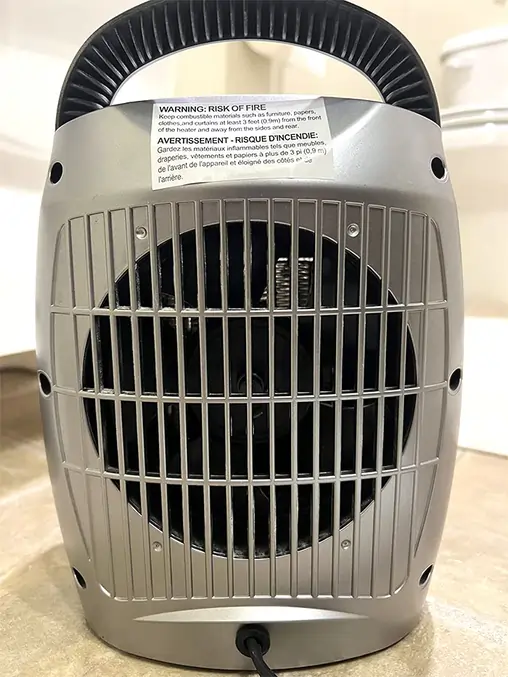 Looking at this ceramic heater from the back side, you can see the built-in fan.
Looking at this ceramic heater from the back side, you can see the built-in fan.
Dry heat is not necessarily bad! Especially, if you live in a humid environment, dry air sucks away superfluous moisture from your home.
By the way: here’s an article about 3 space heaters that don’t dry the air.
And here’s one for the science about space heaters and humidity.
Anyways:
Do you use your hair dryer to heat your room? Likely not, because hair dryers are loud and the hot air quickly cools down as it mixes with the cool air in your room.
And that’s exactly the problem with ceramic heaters.
How infrared heaters distribute heat and how it feels like
Infrared heaters primarily use radiation as their method of heat distribution.
When you’re in front of an infrared heater, the sensation is similar to the direct warmth you feel from the sun on a sunny day or sitting in front of a fireplace.
The heat targets objects and people directly without first warming the surrounding air.
So, infrared heaters even work outdoors. The wind can’t blow infrared radiation away. And if you stand in front of an infrared heater, whether indoors or outdoors, you feel heat.
Infrared heaters are incredibly quick to heat up. After turning mine on, I notice heat within just a few seconds. And after a minute it is outputting heat at full capacity.
Curious about the science behind this? Find out why infrared is hotter than visible light.
Because infrared heaters emit radiation, they don’t need a built-in fan. Infrared heaters are perfectly silent.
“The infrared heater doesn’t need a fan because it doesn’t heat the air, the energy travels through space and heats any solid objects that are in its path (line of sight) as the sun does. It warms ONLY what it’s pointed at and that object then re-radiates the heat.”
A standout benefit of this method is the immediacy of the heat. There’s no waiting for the air to warm up; the moment you turn on an infrared heater, you can feel its heat.
This makes them exceptionally effective in larger or draftier spaces where air-based heating might be less efficient.
But that doesn’t mean they’re limited to large rooms. You can just as well use an infrared heater in a small room, under a table to warm your feet, in your bedroom, living room, etc.
They’re also beneficial in areas where quick, targeted heat is desired, like a chilly garage or a patio during a cold evening. If you’re wondering about their placement, here’s a guide on where to place an infrared heater.
However, it’s worth noting that the heat can be quite directional. If you’re outside the heater’s direct path, you might not feel as warm. It’s essential to position these heaters strategically to maximize their effect.
Here’s something where many people stop. They just assume “an infrared heater heats just in one direction, and the air remains cold”. That’s wrong!
Remember how in the section on “technical energy efficiency” we discussed how all energy eventually ends up as heat?
So, even though an infrared heater emits directional & immediate heat rays, it will over time (just like a ceramic heater), heat the room’s air and raise room temperature.
In fact, when I hold my hand above my infrared heater, I feel hot air rising. That’s why it has hot-air escape slits on top.
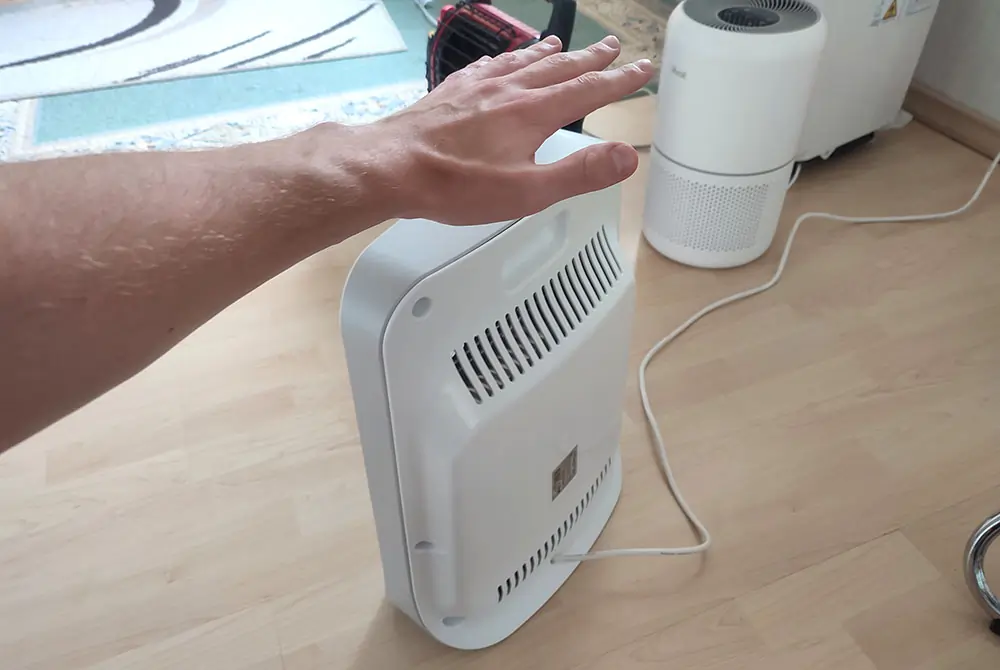
How to optimize a ceramic vs infrared heater’s heating efficiency
Based on everything we know about ceramic heaters and infrared heaters, let’s have a look at the best things you can do to maximize their perceived heat efficiencies!
Here’s how to get the most heat out of your ceramic and infrared heaters:
How to maximize ceramic heater efficiency
Ceramic heaters produce hot air which naturally tries to mix with the cold air in your room.
The only way to increase a ceramic heater’s efficiency is, therefore, to trap the hot air it emits!
Trap hot air in small spaces
Ensure your ceramic heater is placed in an area where its warmth can be effectively trapped, for instance, under a desk or in a smaller room.
Under a desk, you could even install a blanket to the front side of your desk to improve the hot air trapping. Just make sure the blanket doesn’t get too close to the heater’s hot air output.
Also, avoid air drafts from outdoors! For example, close the gap below your door. I recommend getting an under-door air draft blocker (click here to view one on amazon).
Reduce distance
Placing the heater closer to where you sit or work can drastically increase the perceived warmth.
It’s a simple trick, but moving your heater a bit closer can make a world of difference in comfort.
Use in rooms with multiple people
Ceramic heaters are not only bad. So far, I’ve highlighted their shortcomings in comparison to infrared heaters. But there’s one occasion where ceramic heaters perform relatively well:
Ceramic heaters are great for heating rooms with multiple people, for example, family or guests.
With an infrared heater on the other hand, you’d overheat one person in direct line of sight in front of the heater, and the other people would sense indirect heat largely.
Ceramic heaters are very good at evenly heating a whole room which feels much more pleasant when you have guests around.
Efficiency-wise, a ceramic heater in a crowded room maximizes the average perceived heating efficiency per person.
How to maximize infrared heater efficiency
Let’s have a look at how to optimize an infrared heater’s perceived heating efficiency.
Place directly in front of you
Because of the way radiation spreads, the energy density of the rays decreases the farther you are from the infrared heater. This intuitively makes sense.
So, place your infrared heater as close as possible to you. The closer you place it, the hotter it gets.
I did an experiment with a laser thermometer in my post “Are infrared heaters safe indoors?”. And, according to the measurements, the temperature coming from an infrared heater rises exponentially with decreasing distance.
Accordingly, you can increase efficiency exponentially by placing the heater closer to you.
Avoid Obstructions
Obviously, if you place anything between you and your infrared heater, the obstruction blocks off the heat.
Ensure there’s nothing blocking the heater’s path.
However, energy is not wasted! After some time, room temperature will rise (remember: All energy eventually ends up as heat).
So, you essentially transform your infrared heater into a regular convection heater by doing that.
Make use of infrared rays instead!
“The most efficient infrared heater placement is immediately in front of people.”
quote from the guide: Where to place an infrared heater?
How to make a ceramic and an infrared heater more efficient
Some things apply to all heaters, regardless of whether they are ceramic or infrared:
- Insulation: One of the most effective ways to maximize heat efficiency in any space is to minimize the amount of heat that leaves the room. You can do that using insulation.
Proper insulation reduces the amount of heat lost, allowing your heater to do its job without overworking.
You don’t need to renovate your whole home to see results. A regular air draft blocker below the door and carpets already help! - Turn off the heater when you leave the room: While it might seem obvious, only use the heater when you need it. If you’re leaving a room for an extended period, consider turning the heater off or reducing its power.
If you run your heater in your absence, you essentially invest energy but get zero heat perception for it. So, running a heater when you are in a different room causes its perceived heat efficiency to drop to zero.
Power consumption of ceramic and infrared heaters
Almost all space heaters consume 1,500W of power. I’ve tested 21 different heaters and their power consumption, and the result is almost always the same.
There are some exceptions, such as small desk heaters or larger industrial-grade heaters.
But almost every space heater for home-use consumes 1,500W.
This includes both ceramic heaters and infrared heaters. There is absolutely no difference.
The reason is not that 1,500W is some magical number that maximizes heat efficiency or whatever.
1,500W is simply the maximum power a US wall outlet can reliably output.
A standard US wall outlet runs on a voltage of 120V.
And the smallest US circuit breaker trips at 15 Amps.
120 Volts × 15 Amps = 1,800W
So, 1,800W is the maximum power every US wall outlet supports. To not trip the circuit breaker and to allow other devices to run simultaneously, heater manufacturers make their heaters consume 1,500W. The 300 Watts difference is basically a safety margin.
Both infrared heaters and ceramic heaters consume 1,500 Watts of power on their highest setting.
And again, here’s the fundamental point: when it comes to energy consumption, a ceramic heater and an infrared heater with the same wattage will consume exactly the same amount of energy and create exactly the same amount of heat.
“Electric space heaters are ALL THE SAME! (With same wattage.) All 1,200 watt space heaters will put out the SAME amount of heat. Does not matter if they are oil filled, look like a fireplace, or whatever. It is the “watts”.”
The efficiency difference between ceramic and infrared heaters has nothing to do with how much power they consume. It’s all about how ceramic heaters and infrared heaters distribute heat differently.
And, in most cases, with an infrared heater, you have better options to maximize efficiency, since you don’t have to “trap” hot air.
Infrared radiation just feels warm. There’s no need to trap heat.
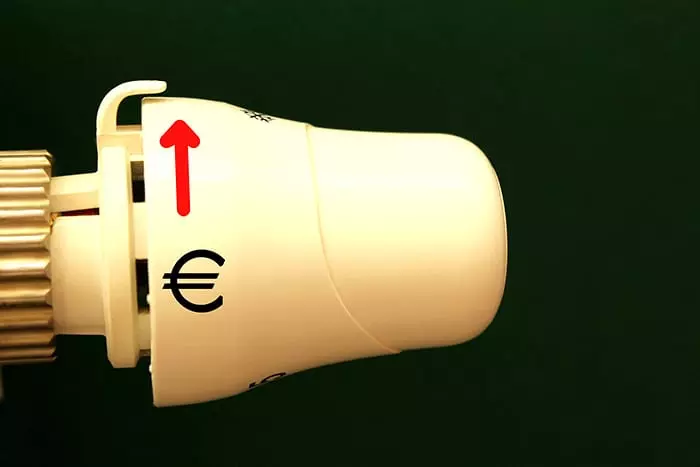
Are ceramic heaters or infrared heaters better for saving energy?
Both ceramic and infrared heaters consume the same amount of power. But it’s easier to run an infrared heater at the lowest setting and still feel warm.
Infrared heaters are better for saving energy. You can run an infrared heater on the lowest power setting and still feel warm immediately after turning it on. Meanwhile, a ceramic heater first has to heat the entire air in your room.
In a poorly insulated room, a ceramic heater possibly can’t even keep up with the heat loss.
So, in the worst case, a ceramic heater’s energy is fully wasted when you run it on the lowest setting.
So, infrared heaters are a much better choice than ceramic heaters for saving energy.
My recommendation is this Dr Infrared Heater (click here to view it on amazon).
Conclusion
In almost all cases, infrared heaters have a better heating efficiency than ceramic heaters.
Ceramic heaters are only worth it if you want to evenly heat a room and you have a lot of time.
Best use cases for ceramic heaters:
- Multiple people around, preferably even heat distribution: At parties, family gatherings, in a tent with multiple people
Ironically, these are the times when you don’t really care about electricity costs.
However, as soon as you’re alone, and you want localized heat (that eventually turns into whole-room heat), infrared heaters are by far the best choice.
Best use cases for infrared heaters:
- Works for both individuals and when multiple people are around: To heat in large rooms, to heat your family sitting on the couch, outdoors, in a shed, in the garage, in a workshop, in your bedroom, etc.
I’d pick an infrared heater over a ceramic heater every day. They are much more versatile. I can use mine anywhere I like and I don’t have to pre-heat the room with an infrared heater.
